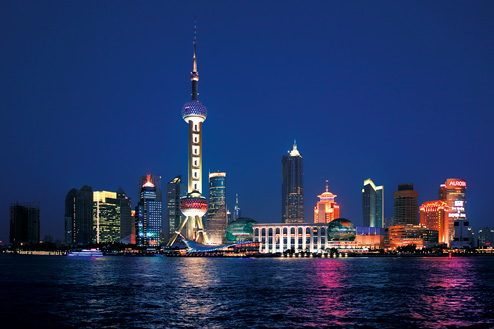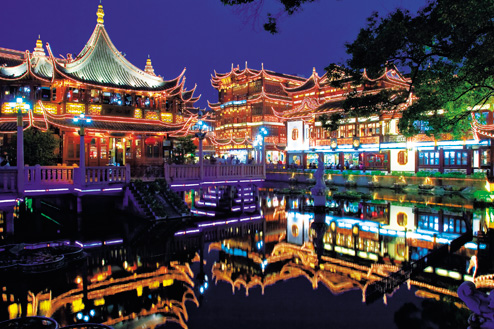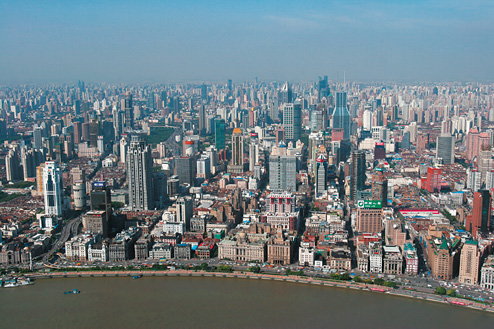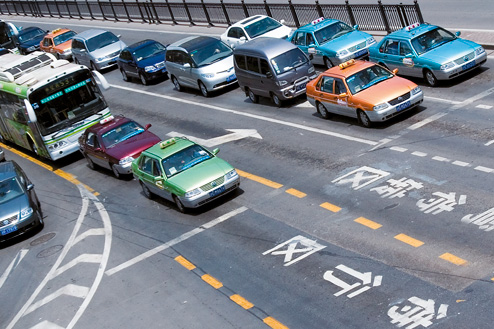Getting Around
Cars have begun to replace bicycles as the favoured mode of transport among Shanghai’s growing middle-classes, and after the ‘mandatory’ Rolex have become the next most popular show of wealth among a group with rising dispensable incomes. In 2006, there were already more than one million car owners, with reports suggesting that numbers are doubling every couple of years. Unsurprisingly, traffic congestion on Shanghai’s roads is a huge problem.
Central Shanghai is surrounded by one major ring-road, Zhongshan Lu, which links Puxi to Pudong via the Nanpu Bridge. Bisecting central Shanghai laterally is Yan’an Lu, running westwards to Hongqiao Airport. Splitting the city up and down is Gonghe Xin Lu/Chongqing Nan Lu, running north towards Shanghai Railway Station. Smaller roads of great importance include the shopping strips of Huaihai Lu and Nanjing Lu. Fuxing Lu, which is parallel to these, leads into the Fuxing Tunnel that runs under the Huangpu River into the financial district of Pudong.
Of course, only a relatively small part of this enormous population can afford the luxury of a private car, with the remainder relying on public buses, bikes, scooters, taxis and the Metro system. Buses are cheap and routes are plentiful, but the daily rush-hour crowding from 07:30 to 10:00 and 17:00 to 19:30, both inside the bus and on the roads, can make journeys long and uncomfortable – a situation not helped by the lack of specified bus lanes. Dodging these buses, often with a hair’s width to spare, are the city’s huge fleet of taxis: cheap in comparison to any other major international city, and plentiful, except during rain, when finding an empty taxi becomes next to impossible. The Metro is also cheap, between ¥3 and ¥9 for a single ticket, and much faster than overground transport. It is, however, still afflicted by the daily pre and post-work crush.
The government wants to ensure that 30% of all journeys will be made on public transport by World Expo 2010. To aid this, it is furiously building a series of new Metro lines, three of which (lines 6, 8 and 9) opened in December 2007. Unveiled at the same time was the new extension of Line 4 which now runs like a ring road all the way around the city through both Puxi and Pudong. More lines and extensions are in the pipeline, with the plan being to have 13 lines operating by 2012. The high speed Maglev train currently runs from Pudong Airport to a stop 30 minutes from the city centre. Plans to extend the line further into Puxi are presently on hold because of environmental and financial concerns.
Central Shanghai is surrounded by one major ring-road, Zhongshan Lu, which links Puxi to Pudong via the Nanpu Bridge. Bisecting central Shanghai laterally is Yan’an Lu, running westwards to Hongqiao Airport. Splitting the city up and down is Gonghe Xin Lu/Chongqing Nan Lu, running north towards Shanghai Railway Station. Smaller roads of great importance include the shopping strips of Huaihai Lu and Nanjing Lu. Fuxing Lu, which is parallel to these, leads into the Fuxing Tunnel that runs under the Huangpu River into the financial district of Pudong.
Of course, only a relatively small part of this enormous population can afford the luxury of a private car, with the remainder relying on public buses, bikes, scooters, taxis and the Metro system. Buses are cheap and routes are plentiful, but the daily rush-hour crowding from 07:30 to 10:00 and 17:00 to 19:30, both inside the bus and on the roads, can make journeys long and uncomfortable – a situation not helped by the lack of specified bus lanes. Dodging these buses, often with a hair’s width to spare, are the city’s huge fleet of taxis: cheap in comparison to any other major international city, and plentiful, except during rain, when finding an empty taxi becomes next to impossible. The Metro is also cheap, between ¥3 and ¥9 for a single ticket, and much faster than overground transport. It is, however, still afflicted by the daily pre and post-work crush.
The government wants to ensure that 30% of all journeys will be made on public transport by World Expo 2010. To aid this, it is furiously building a series of new Metro lines, three of which (lines 6, 8 and 9) opened in December 2007. Unveiled at the same time was the new extension of Line 4 which now runs like a ring road all the way around the city through both Puxi and Pudong. More lines and extensions are in the pipeline, with the plan being to have 13 lines operating by 2012. The high speed Maglev train currently runs from Pudong Airport to a stop 30 minutes from the city centre. Plans to extend the line further into Puxi are presently on hold because of environmental and financial concerns.













